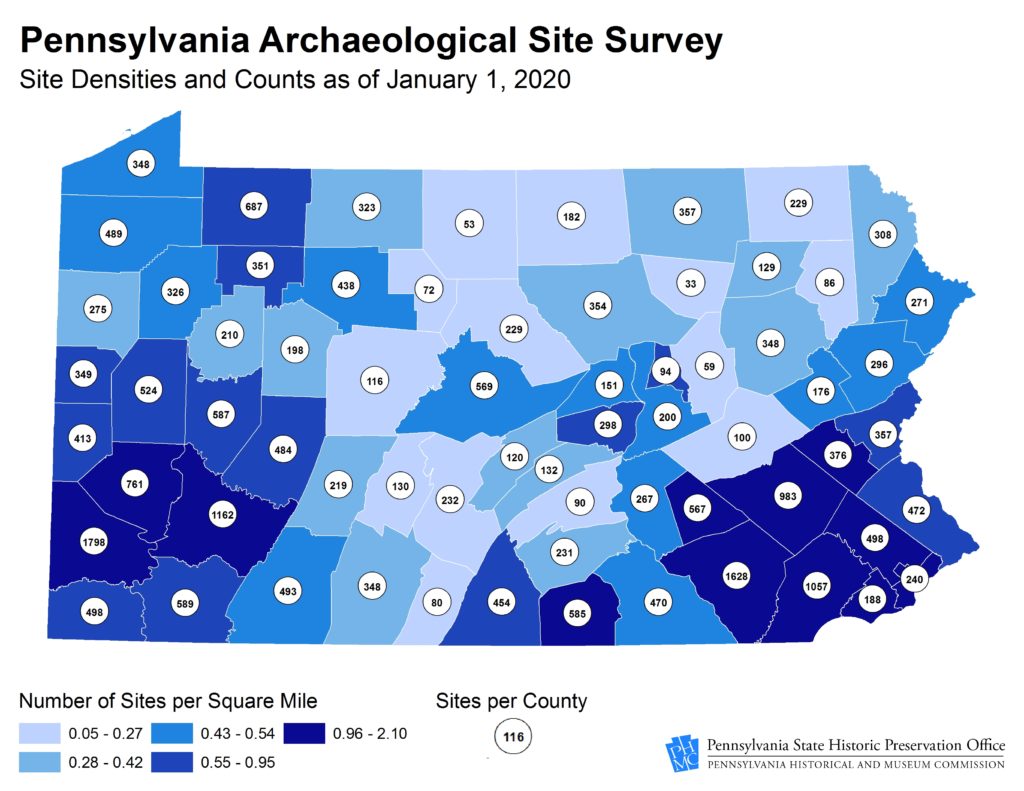The PHMC has been a steward of archaeological site information in Pennsylvania since the late 1920s.
This started with the Pennsylvania Historical Commission’s acquisition of the Pennsylvania Indian Survey in 1927, continued with the issuing of Smithsonian Trinomial site numbers beginning in the 1940s, and was formalized with the creation of the Pennsylvania Archaeological Site Survey in the 1960s-70s.
While the Commonwealth has led or funded a handful of efforts to document archaeological sites over the years, the reality is that we could not do this without the hard work and local expertise of hundreds of individuals, universities, museums, and contract firms that have diligently located sites and reported their findings since the 1950s.
This trend is very much alive in 2020, and in this blog post we’d like to highlight some of the projects and people who contributed to the PASS files last year.
The First PASS Report
Anyone interested in the history of site recording in Pennsylvania should check out Ira Smith and Jim Herbstritt’s 1977 document, “Status Report on the Pennsylvania Archaeological Site Survey,” which is held on file at the SHPO in Harrisburg. In the report, Smith and Herbstritt reconstructed a fascinating history of surveys that occurred across Pennsylvania since the late 1800s.
More recently, SHPO archaeologists put out a yearly report that summarizes site recording activities: the who, where, why, and when of site recording!
The 2019 PASS Report
The report covering 2019 can be found here: https://www.phmc.pa.gov/Preservation/About/Documents/PASS2020_Report.pdf. Please contact the CRGIS staff at ra-crgis@pa.gov if you are interested in seeing older reports.

This year we took a different approach to the PASS report and asked a series of guest authors to write about their site recording projects from 2019. What we have is a nice cross-section of cultural resource management (CRM), university, and avocational efforts to survey new sites, benefit from local knowledge, and tackle legacy data.
The Fred Veigh Collection
Statewide we recorded a total of 425 new sites in 2019, but a quarter of them came from the State Museum’s massive project to catalog the Fred Veigh collection!
While SHPO staff have helped to train and supervise the interns and volunteers who are creating site records in CRGIS, the lion’s share of the work is being completed by a crew of curators and volunteers lead by Andrea Carr.

In 2019 they processed 108 previously-unrecorded sites in Somerset and Washington Counties—most of which came from the Myersdale and Washington East topo quads.
Over the next few years, the Veigh collection will continue to enhance our understanding of archaeology in certain locales.
David Peters Collection
In May 2019, David Peters and his wife visited the SHPO in Harrisburg to deliver a batch of 46 site forms that represent decades of collection and documentation in Chester, Lancaster, and Berks Counties.

Mr. Peters is a member and Certified Archaeological Technician with the Archaeological Society of Maryland and serves on the board of one of the ASM’s chapters, the Archaeological Society of the Northern Chesapeake.
As we processed the site forms, we added 18 new sites to the PASS files and processed 28 site updates, all of which contained better mapping and images than what had been available in CRGIS.
We look forward to seeing additional sites from this collection!
Otter Timber Management Project
Since the 1990s, the majority of newly recorded sites have been identified by CRM surveys, and in most years we can point out one industry or even one project that accounted for most of those sites.
Last year many of the survey projects were small in scale and each recorded only a handful of sites, if any. The largest contributor among CRM projects in 2019 was the Otter Timber Management project in the Allegheny National Forest (ANF), from which 25 new archaeological and historical resources and 18 resource updates were reported by Rebecca Knapp.

The result was a sample of ANF archaeology that includes common site types such as oil and gas sites, lumber camps, and small pre-contact open habitations.
Legacy Collections at Bucks County Community College
Historic preservation students and volunteers under professor Meagan Ratini documented sites that were excavated by Bucks County Community College since the 1970s.
Although the project was small, we were able to record three new sites and obtain updates (including a corrected site location) for two older sites. The submissions included two pottery works and the foundation the Wynkoop House—an 18th century dwelling built by a family of Dutch settlers.

Broad Mountain Upland Sites Project
Continuing with the theme of university research, the Broad Mountain upland sites project was conducted by Jennifer Falchetta for her master’s thesis at Monmouth University.
The project relied on informant data from local collectors as well as field observations of non-professional excavation. Seventeen new sites were recorded through these methods, providing new information on upland settlement patterns in the Broad Mountain area of Carbon County as well as a body of comparative data for other nearby sites.

Want to learn more?
For more details about these projects see the 2019 report. As always, many thanks to all of our site recorders across Pennsylvania!
Great post detailing the culmination of lots of dedicated work!